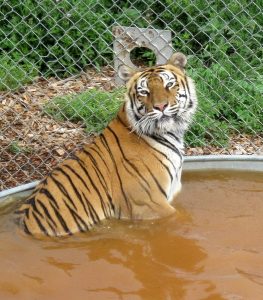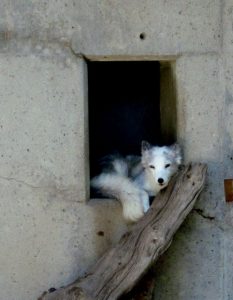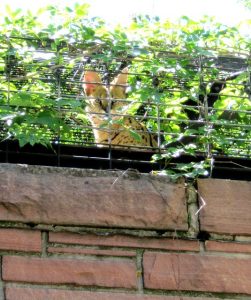 If someone demanded I use “human-animal bond” and “amblyopia” in the same sentence early in my career, I would’ve replied, “Huh?” I knew amblyopia referred to the functional blindness that occurs when lack of proper eye alignment results in faulty brain-eye connections. Instead of both eyes working together to form a combined image, each eye sees a slightly different one. If left uncorrected, the brain would ignore one image. Over time this could result in one physically normal eye incapable of vision. Back then, I would have said that had nothing to do with the bond.
If someone demanded I use “human-animal bond” and “amblyopia” in the same sentence early in my career, I would’ve replied, “Huh?” I knew amblyopia referred to the functional blindness that occurs when lack of proper eye alignment results in faulty brain-eye connections. Instead of both eyes working together to form a combined image, each eye sees a slightly different one. If left uncorrected, the brain would ignore one image. Over time this could result in one physically normal eye incapable of vision. Back then, I would have said that had nothing to do with the bond.
But then a dramatic encounter with human-animal bond-related amblyopia changed my mind. I’d finished the manuscript for the bond- and behavior-based The Art of Veterinary Practice and awaited comments from the peer-review committee. All but one member replied promptly and favorably. When the last review finally arrived, it made no sense to me. The reviewer said the book shouldn’t be published because it didn’t discuss common bond- and behavior-based veterinary issues. He then went on to provide specific examples. But not only had I discussed those issues, I’d devoted entire chapters to them! How could this be?
With visions of several years of hard work going down the toilet, I called my editor for the answer. She assured me that all was not lost. I’d written a text that discussed veterinary interactions from the client and animal perspectives to sensitize practitioners to these other orientations. But the reviewer had focused strictly on the veterinarian’s perspective for so long, these other orientations didn’t exist for him. He was intellectually blind to them. Because my editor had encountered this phenomenon before, she had prepared a list of alternate reviewers.
After that harrowing experience, the concept of intellectual amblyopia as it related to the bond as well as animal behavior continued to fascinate me. In a way it made sense. If our brains could zero out the one of two visual images that didn’t align, why couldn’t it ignore information that conflicted with what our brains wanted to perceive as real?
Over the years, I’ve encountered many examples of human-animal bond amblyopia. Each of these helped me understand human-animal interactions that otherwise would make no sense. Recognizing these also helped me to recognize the futility of trying to change people who had the relationship they wanted with the animal they had. Granted, accepting these human orientations was difficult when the negative effect on the animals seemed so obvious to me. Over time it lessened. But it never became easy.
 One recurrent theme in these amblyopic bonds is the human need for control. However, the definition of how to control animals has changed over the years. In the past, more people thought they could do this with punishment; today more think they only can do it with love. Or even just treats. In some cases, I also knew that feelings of impotence that originated in childhood facilitated these distorted views. But I never saw any studies on the subject that supported or
One recurrent theme in these amblyopic bonds is the human need for control. However, the definition of how to control animals has changed over the years. In the past, more people thought they could do this with punishment; today more think they only can do it with love. Or even just treats. In some cases, I also knew that feelings of impotence that originated in childhood facilitated these distorted views. But I never saw any studies on the subject that supported or  disproved this observation.
disproved this observation.
While recovering from an unplanned yellow jacket encounter this summer, some perverse part of my brain suggested I consider examples of human-wild animal bond animal amblyopia. And what better way to do that than watch the old Animal Planet series, “Fatal Attractions”?
For those unfamiliar with the series, it describes people who form amblyopic relationships with wild or dangerous domestic animals that don’t end well. Sometimes the owner pays the price when real life intrudes on the fantasy; other times a friend or visitor pays it. Often the animals pay the price for their owners’ distorted images of their bonds .
The majority of the owners portrayed in the series struck me as delusional. They all believed they had a special connection with these dangerous animals that protected them. Some attributed it to their great love of the animals. But others admitted that the adrenaline rush they got when they interacted with dangerous animals fueled the relationship. Some among the latter would provoke the animals to attack and even bite them so they could prove their superiority. None acknowledged the unnatural life their obsession caused the animals to live even under the best of circumstances. People with strong control issues and training backgrounds believed they could train even the wildest animals, including venomous snakes to display grossly out-of-context behaviors. Those who challenged their views were ignored, accused of ignorance, or not loving animals as much as they did. Regardless how much the animals, they, and other people suffered, these people rarely expressed any regrets.
Those who did regret what they did intrigued me the most. They made me think that perhaps something much more fundamental than childhood trauma was the culprit here. For generations, kids living in stable home environments have collected lightning bugs, lizards, snakes, and baby anythings that moved. Sometimes with help from older siblings or adults, they learned to summon the self-control to free the animals. Other times, they watched the lights go out in their lightning bug night-lights as the insects died one by one. Or they discovered the dead snake, lizard, or baby bird all their love couldn’t make live in captivity. In that instant, I think all those kids and many still today learned two lessons that fatal attractions wannabees never do: empathy and self-control.
All these thoughts brought me back to something a very wise person said to me years ago: Sometimes the ultimate act of love is knowing when to let go. Nowhere in our interactions with animals does this ring more true that when the image of what an animal’s presence means to us looms so large, it threatens to blind us to the needs of the animal.
But then a dramatic encounter with human-animal bond-related amblyopia changed my mind. I’d finished the manuscript for the bond- and behavior-based The Art of Veterinary Practice and awaited comments from the peer-review committee. All but one member replied promptly and favorably. When the last review finally arrived, it made no sense to me. The reviewer said the book shouldn’t be published because it didn’t discuss common bond- and behavior-based veterinary issues. He then went on to provide specific examples. But not only had I discussed those issues, I’d devoted entire chapters to them! How could this be?
With visions of several years of hard work going down the toilet, I called my editor for the answer. She assured me that all was not lost. I’d written a text that discussed veterinary interactions from the client and animal perspectives to sensitize practitioners to these other orientations. But the reviewer had focused strictly on the veterinarian’s perspective for so long, these other orientations didn’t exist for him. He was intellectually blind to them. Because my editor had encountered this phenomenon before, she had prepared a list of alternate reviewers.
After that harrowing experience, the concept of intellectual amblyopia as it related to the bond as well as animal behavior continued to fascinate me. In a way it made sense. If our brains could zero out the one of two visual images that didn’t align, why couldn’t it ignore information that conflicted with what our brains wanted to perceive as real?
Over the years, I’ve encountered many examples of human-animal bond amblyopia. Each of these helped me understand human-animal interactions that otherwise would make no sense. Recognizing these also helped me to recognize the futility of trying to change people who had the relationship they wanted with the animal they had. Granted, accepting these human orientations was difficult when the negative effect on the animals seemed so obvious to me. Over time it lessened. But it never became easy.
While recovering from an unplanned yellow jacket encounter this summer, some perverse part of my brain suggested I consider examples of human-wild animal bond animal amblyopia. And what better way to do that than watch the old Animal Planet series, “Fatal Attractions”?
For those unfamiliar with the series, it describes people who form amblyopic relationships with wild or dangerous domestic animals that don’t end well. Sometimes the owner pays the price when real life intrudes on the fantasy; other times a friend or visitor pays it. Often the animals pay the price for their owners’ distorted images of their bonds .
The majority of the owners portrayed in the series struck me as delusional. They all believed they had a special connection with these dangerous animals that protected them. Some attributed it to their great love of the animals. But others admitted that the adrenaline rush they got when they interacted with dangerous animals fueled the relationship. Some among the latter would provoke the animals to attack and even bite them so they could prove their superiority. None acknowledged the unnatural life their obsession caused the animals to live even under the best of circumstances. People with strong control issues and training backgrounds believed they could train even the wildest animals, including venomous snakes to display grossly out-of-context behaviors. Those who challenged their views were ignored, accused of ignorance, or not loving animals as much as they did. Regardless how much the animals, they, and other people suffered, these people rarely expressed any regrets.
Those who did regret what they did intrigued me the most. They made me think that perhaps something much more fundamental than childhood trauma was the culprit here. For generations, kids living in stable home environments have collected lightning bugs, lizards, snakes, and baby anythings that moved. Sometimes with help from older siblings or adults, they learned to summon the self-control to free the animals. Other times, they watched the lights go out in their lightning bug night-lights as the insects died one by one. Or they discovered the dead snake, lizard, or baby bird all their love couldn’t make live in captivity. In that instant, I think all those kids and many still today learned two lessons that fatal attractions wannabees never do: empathy and self-control.
All these thoughts brought me back to something a very wise person said to me years ago: Sometimes the ultimate act of love is knowing when to let go. Nowhere in our interactions with animals does this ring more true that when the image of what an animal’s presence means to us looms so large, it threatens to blind us to the needs of the animal.